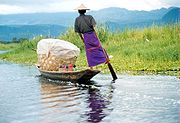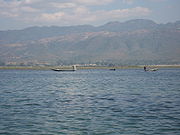
Intha people
Encyclopedia


Tibeto-Burman languages
The Tibeto-Burman languages are the non-Chinese members of the Sino-Tibetan language family, over 400 of which are spoken thoughout the highlands of southeast Asia, as well as lowland areas in Burma ....
ethnic group living around Inle Lake
Inle Lake
Inle Lake is a freshwater lake located in the Nyaungshwe Township of Taunggyi District of Shan State, part of Shan Hills in Myanmar . It is the second largest lake in Myanmar with an estimated surface area of , and one of the highest at an altitude of...
. They speak an archaic dialect of Burmese
Burmese language
The Burmese language is the official language of Burma. Although the constitution officially recognizes it as the Myanmar language, most English speakers continue to refer to the language as Burmese. Burmese is the native language of the Bamar and related sub-ethnic groups of the Bamar, as well as...
, and are believed to have come from the Dawei
Dawei
-Transport:Only recently Dawei was connected to the rest of Myanmar by road and rail. There are plans to construct a deepwater port in Dawei. In November 2010, the Myanmar Port Authority signed a USD $8.6 billion deal with Italian-Thai Development to develop a deep sea port at Dawei...
area. They often live on Inle Lake
Inle Lake
Inle Lake is a freshwater lake located in the Nyaungshwe Township of Taunggyi District of Shan State, part of Shan Hills in Myanmar . It is the second largest lake in Myanmar with an estimated surface area of , and one of the highest at an altitude of...
, and support themselves through the tending of vegetable farms on floating gardens. Also, the Intha are known for their leg-rowing techniques, and are traditionally Buddhists.
The people of Inle Lake (called Intha), some 70,000 of them, live in four cities bordering the lake, in numerous small villages along the lake's shores, and on the lake itself. The entire lake area is in Nyaung Shwe
Nyaung Shwe
Nyaung Shwe is a town a few kilometers north of Inle Lake in the Shan State of Myanmar.It is located south of Sakangyi and southwest of Taunggyi. Bawrithat Pagoda lies in the southern part of the town....
township. The population consists predominantly of Intha, with a mix of other Shan, Taungyo, Pa-O
Pa-O
The Pa-Oh form an ethnic group in Burma, comprising approximately 600,000. The Pa-Oh form the second largest ethnic group in Shan State, and are classified as part of the "Shan National Race" by the government, although they are believed to be of Tibeto-Burman stock, and are ethnolinguistically...
(Taungthu), Danu
Danu people
The Danu people are a sub-ethnic group of the Bamar, predominantly populating the areas near Pindaya Caves, in Shan State of Burma. They speak an archaic dialect of Burmese.-External links:*...
, Kayah, Danaw and Bamar
Bamar
The Bamar are the dominant ethnic group of Burma , constituting approximately two-thirds of the population. The Bamar live primarily in the Irrawaddy basin, and speak the Burmese language, which is also the official language of Burma. Bamar customs and identity are closely intertwined with general...
ethnicities. Most are devout Buddhists, and live in simple houses of wood and woven bamboo
Bamboo
Bamboo is a group of perennial evergreens in the true grass family Poaceae, subfamily Bambusoideae, tribe Bambuseae. Giant bamboos are the largest members of the grass family....
on stilts; they are largely self-sufficient farmers.
Most transportation on the lake is traditionally by small boats, or by somewhat larger boats fitted with outboard motors. Local fishermen are known for practicing a distinctive rowing style which involves standing at the stern on one leg and wrapping the other leg around the oar. This unique style evolved for the reason that the lake is covered by reeds and floating plants making it difficult to see above them while sitting. Standing provides the rower with a view beyond the reeds. However, the leg rowing style is only practiced by the men. Women row in the customary style, using the oar with their hands, sitting cross legged at the stern.

